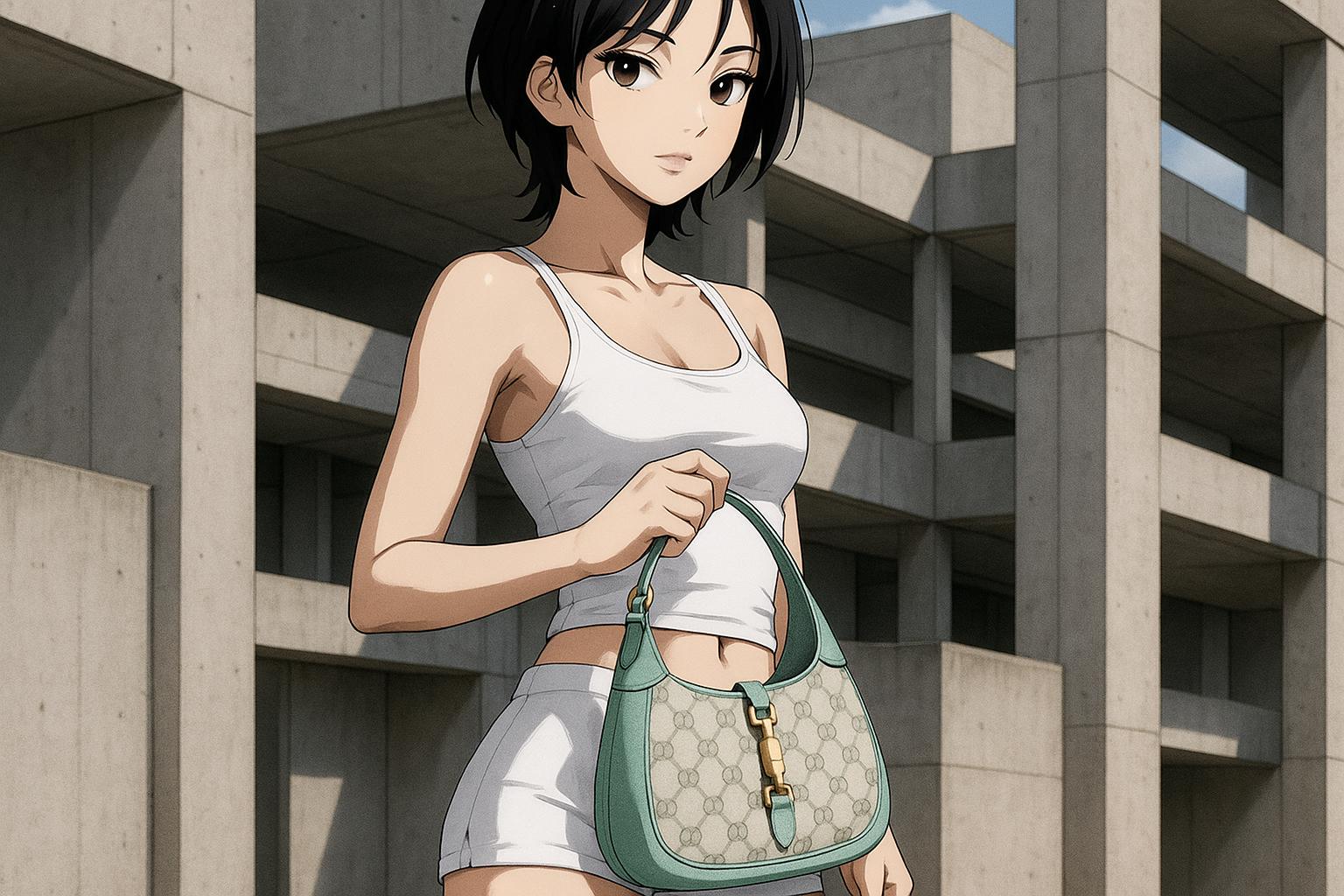Gucci’s new creative director, Sabato De Sarno, embraces minimalism and youth-focused designs in his debut collection, signalling a strategic shift from maximalism to streamlined elegance aimed at modernising the iconic Italian brand for a new generation.
Gucci has long been an emblem of both opulence and innovation in the fashion industry, a reputation built upon a layered history and bold creative direction. The brand’s evolution is marked by its ability to adapt while remaining steadfast to its Italian craftsmanship and timeless aesthetics. From Tom Ford’s sultry minimalism in the 1990s through to the exuberant maximalism of Alessandro Michele, Gucci has continuously reinvented itself, culminating in the recent appointment of Sabato De Sarno. His vision, infused with simplicity reminiscent of Brutalist architecture, promises to chart a new course for the house as it seeks to resonate with a modern audience.
As De Sarno debuted his inaugural collection, ‘Gucci Ancora’, at Milan Fashion Week, he pivoted away from the previous eras dominated by flamboyant designs. Instead, his collection showcased a streamlined aesthetic that champions body confidence and an appeal to Gen-Z sensibilities. This change is not merely cosmetic; it signifies a strategic shift aimed at rejuvenating the brand amid market challenges and shifting consumer preferences. Contemporary garments such as white tanks and short shorts, coupled with platform loafers, underline a youth-oriented focus that contrasts sharply with Michele’s maximalist approach.
The Gucci legacy, established in 1921, has always been intricately linked to its handbags—each narrating not just the story of luxury but also cultural moments throughout decades. Iconic designs like the Jackie, Dionysus, and Marmont remain as relevant today as when they were first introduced. The versatility of these bags, which blend elegance with modernity, accentuates their status as both fashion statements and investment pieces—further enhancing their allure for discerning shoppers.
Gucci’s ability to captivate the celebrity sphere speaks volumes about its influence. Figures like Harry Styles have made waves by redefining masculinity in custom Gucci suits, while Lady Gaga captivated audiences during her ‘House of Gucci’ promotional tour. These moments not only illustrate the brand’s impact on pop culture but also underscore its enduring desirability among style icons. This summer, Gucci unveils a selection of pieces designed to augment any wardrobe and encapsulate the brand’s luxurious essence.
Among the standout items available for purchase, a silk dress adorned with a crystal Horsebit detail embodies modern elegance, rooted in Gucci’s equestrian heritage. Priced at £3,300, this dress is a luxurious addition for those keen to make a summer statement. A glittering embroidered GG canvas mini skirt, meanwhile, offers a playful nod to Y2K fashion—perfect for day-to-night transitions, available at £1,500.
Additionally, the Gucci Jackie Medium Bag continues to be a beloved staple, exemplifying the brand’s craftsmanship and style, especially in its fresh mint rendition priced at £2,850. The low-waist denim jacquard shorts, reminiscent of the Y2K era and retailing at £1,050, present a relaxed yet chic option for warmer days. Completing this capsule is the quintessential Women’s Horsebit Ballet Flat, capping off summer looks with a price tag of £695.
As Gucci stands on the brink of transformation under De Sarno, the juxtaposition of heritage and innovation is more pertinent than ever. With an evolving aesthetic, a focus on sustainability, and fresh interpretations of iconic pieces, the brand is poised to maintain its status as a hallmark of high fashion. Indeed, the anticipation surrounding Demna’s imminent direction also casts a hopeful light on the future, as the brand solemnly walks the line between tradition and forward-thinking design, ensuring its place in the hearts—and wardrobes—of fashion aficionados for generations to come.
Reference Map:
1. Paragraphs 1, 2, 4, 5, 10
2. Paragraph 2, 3, 4, 6
3. Paragraphs 3, 6
4. Paragraph 4
5. Paragraph 2
6. Paragraph 4
Source: Noah Wire Services
- https://www.hellomagazine.com/hfm/490290/5-gucci-items-we-are-adding-to-our-cart-this-summer/ – Please view link – unable to able to access data
- https://www.apnews.com/article/gucci-sabato-de-sarno-debut-milan-fashion-week-2023 – Sabato De Sarno made his highly anticipated debut as Gucci’s creative director at Milan Fashion Week with his collection titled ‘Gucci Ancora.’ After joining from Valentino, De Sarno’s collection differed from previous eras under Tom Ford and Alessandro Michele, focusing on simplicity and essentiality influenced by Brutalist architecture. The collection presented a body-confident, Gen-Z-appealing aesthetic with pieces like white tanks, short shorts, and platform loafers. Hollywood stars, including Julia Roberts and Ryan Gosling, attended the event. Despite anti-fur protests, the show proceeded, though relocated from Milan’s streets to a showroom due to rain. De Sarno’s vision for Gucci aims to redefine and rejuvenate the brand, with more to unfold in the future. ([apnews.com](https://apnews.com/article/8258bd57fe96fc22f7f5e6b0ac502f5d?utm_source=openai))
- https://www.whowhatwear.com/best-gucci-bags-uk – This article explores the timeless appeal and history of iconic Gucci handbags, highlighting their enduring relevance in fashion. With origins dating back to 1921, Gucci began as a luggage company and evolved into a luxury label renowned for creating coveted handbags that balance elegance, heritage, and modernity. Key designs include the Gucci 1955 Horsebit, Jackie 1961, Dionysus, Marmont, Ophidia, Diana, Blondie, and Horsebit Chain. Each bag reflects cultural moments and design evolutions shaped by influential creative directors like Tom Ford, Alessandro Michele, and Sabato De Sarno. Gucci’s return to its heritage with current designs, such as the Giglio bag, symbolizes a new era under incoming creative director Demna. These bags are celebrated not only for their craftsmanship and style but also for their historical significance and popularity among celebrities like Princess Diana, Jackie Kennedy, Harry Styles, and Bella Hadid. Gucci’s handbags are portrayed as both stylish and smart investment pieces, retaining value and evolving through subtle reinventions. The article offers a detailed guide for fashion enthusiasts and collectors, emphasizing the brand’s capacity to merge retro charm with contemporary chic. ([whowhatwear.com](https://www.whowhatwear.com/best-gucci-bags-uk?utm_source=openai))
- https://www.apnews.com/article/gucci-recasts-itself-milan-fashion-week-2023 – During Milan Fashion Week, Gucci unveiled its post-Alessandro Michele era with a minimalist collection characterized by a rock ‘n’ roll vibe, less eccentricity, and a focus on basics. The show featured oversized jackets, long john-leggings, bright cowboy boots, and a subdued color palette. Notable attendees included Nick Cave and Idris Elba. Dsquared2 presented a provocative collection symbolizing today’s bold, boundary-pushing youth, with a mix of jock-wear, lace camisoles, and a decorative onesie challenging gender stereotypes. Family First featured kilts and tailored looks while 1017 ALYX 9SM offered street-smart fashion. Billionaire by Philipp Plein celebrated mature men with luxurious, high-end garments, highlighting craftsmanship and rejecting the trend of using young models. ([apnews.com](https://apnews.com/article/671cde5c2f5c731be5996981179c30bf?utm_source=openai))
- https://www.ft.com/content/gucci-sabato-de-sarno-autumn-winter-2024-collection – Gucci’s latest womenswear show, the second by creative director Sabato De Sarno, featured a youthful and sexy collection for autumn/winter 2024. Characterized by high hemlines, mini shorts, boxy jackets with knee-high boots, and sheer, delicate lace dresses, De Sarno’s vision embraces femininity and boldness. Notable details included crystal embellishments on masculine coats and trailing fabric elements for red-carpet appeal. Held at the Fonderia Carlo Macchi, the star-studded event marked another step in De Sarno’s effort to redefine Gucci’s aesthetic, shifting from Alessandro Michele’s maximalist, romantic style to a more stripped-back and accessible look. Amid declining sales, De Sarno’s innovative designs aim to rekindle interest in Gucci and drive revenue growth, while introducing new accessories likely to become commercial successes. De Sarno emphasizes a realistic approach to fashion, balancing dreams with the everyday. ([ft.com](https://www.ft.com/content/f5f453ff-dcba-4c2f-88f8-ba7052dcef54?utm_source=openai))
- https://www.apnews.com/article/gucci-sabato-de-sarno-menswear-debut-milan-fashion-week-2023 – Sabato De Sarno, Gucci’s new creative director, made his menswear debut at Milan Fashion Week with a collection titled ‘Ancora.’ His second runway presentation since taking the helm a year ago featured shimmery and subversive classics. De Sarno showcased pieces echoing his previous womenswear collection, such as a deep red leather jacket and a zipped navy jacket with jeans. The lineup included streamlined double-breasted jackets, long trenches, and plain pea coats, which nodded to Gucci’s utilitarian past. The logo was used sparingly, with subtle branding on bags and suits. The collection also featured bondage elements, like trailing silk ties and half gloves. Key looks included crystal-covered tanks and shimmery lurex coats. De Sarno emphasized that the collection was about freedom and euphoria, moving the show to a new industrial venue. Front-row attendees included Elliot Page and Idris Elba. ([apnews.com](https://apnews.com/article/2708a2f226a916200215780f294e6e41?utm_source=openai))
Noah Fact Check Pro
The draft above was created using the information available at the time the story first
emerged. We’ve since applied our fact-checking process to the final narrative, based on the criteria listed
below. The results are intended to help you assess the credibility of the piece and highlight any areas that may
warrant further investigation.
Freshness check
Score:
8
Notes:
The narrative includes recent developments such as Sabato De Sarno’s appointment and his inaugural collection, indicating a current focus on Gucci’s evolution. However, it does not explicitly mention any recent breaking news or entirely new product launches, which might suggest it is not entirely up-to-date.
Quotes check
Score:
0
Notes:
There are no direct quotes in the text to verify.
Source reliability
Score:
7
Notes:
The narrative originates from Hello Magazine, which is well-known for its celebrity and fashion coverage but may not be as rigorously fact-checked as major news outlets.
Plausability check
Score:
9
Notes:
The claims about Gucci’s evolution and product offerings are plausible and consistent with known trends in the fashion industry.
Overall assessment
Verdict (FAIL, OPEN, PASS): PASS
Confidence (LOW, MEDIUM, HIGH): MEDIUM
Summary:
The narrative is plausible and discusses recent developments in Gucci’s fashion direction, but it lacks direct quotes and its freshness is not fully current with very recent events.













